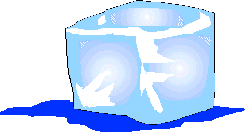Melting Ice
Science Lesson Plan
Students will observe the melting of ice and understand the basic physical changes that occur. They will gain knowledge of how different substances change the rate of melting.

bag of ice; coarse, rock, or table salt; commercial melting compound (such as Prestone Driveway Heat); pie tins; timers for each group
- Discuss with the class the properties of water and ice, the definition of melting and melting point. A simple introduction to the states of matter would also provide a good background and starting point for this lesson.
- Brainstorm with your class and write down on the board ideas and concepts concerning the physical change that occurs during melting. Ascertain the knowledge level of the class.
- Ask some questions during the brainstorming session:
- Why does water freeze at 0C? [Molecules move with less energy, slower, as temperature drops]
- What happens when ice melts? [Rigid crystalline structure of bonds in water molecules break--bonds become less rigid]
- At what temperature does ice begin to melt? [Close to the freezing point of water, 0 C]
- What physical conditions make ice melt? [Increase in temperature, salt, water]
- Explain to the students that the class will be timing the melting of ice in air and ice with different substances added.
- Have students predict the melting times for the experiments. They can use the Data Sheet included with this lesson.
- Do the experiment:
- Have at least 4 students per group, one of them designated Recorder to write down observations. Give each group 4 pie tins (3 will be used in the experiment), some ice, salt, and commercial melting compound.
- Have them place an equal number of ice cubes in each of 3 pie tins. Have the Recorder ready to start and stop the clock.
- Have the students place the salt and commercial compound on the ice at the same time and have the Recorder start the clock.
- The group should decide when the ice is completely melted in each tin and mark it on their data sheet.
- Have the students come up with conclusions as to the difference in melting times.
Have each group share their results and conclusions with the class. Discuss students' explanations, adding additional info as necessary.
Were students able to give input during brainstorming? Did they understand the definition of melting and the basic properties of ice and water? Were the results and conclusions they made logical and defensible?


